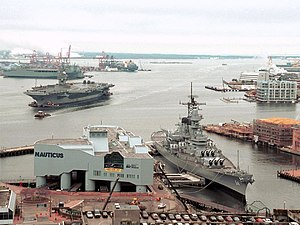
Back متحف بحري Arabic Schifffahrtsmuseum German Museo marítimo Spanish Meremuuseum Estonian Ontzi museo Basque Musée maritime French Pomorski muzej Croatian 海事博物館 Japanese 해양박물관 Korean Scheepvaartmuseum Dutch
This article includes a list of general references, but it lacks sufficient corresponding inline citations. (November 2013) |



A maritime museum (sometimes nautical museum) is a museum specializing in the display of objects relating to ships and travel on large bodies of water. A subcategory of maritime museums are naval museums, which focus on navies and the military use of the sea.
The great prize of a maritime museum is a historic ship (or a replica) made accessible as a museum ship, but as these are large and require a considerable budget to maintain, many museums preserve smaller or more fragile ships or partial ships within the museum buildings. Most museums exhibit interesting pieces of ships (such as a figurehead or cannon), ship models, and miscellaneous small items associated with ships and shipping, like cutlery, uniforms, and so forth.
Ship modellers often have a close association with maritime museums; not only does the museum have items that help the modeller achieve better accuracy, but the museum provides a display space for models larger than will comfortably fit in a modeller's home, and of the museum is happy to take a ship model as a donation. Museums will also commission models.
There are thousands of maritime museums in the world. Many belong to the International Congress of Maritime Museums, which coordinates members' efforts to acquire, preserve, and display their material. There is a risk that too many maritime museums might dilute the experience for the public, while a poorly managed museum might put other municipalities off from the idea of hosting such a museum.[1]
At 80 acres (32 ha) the Chatham Historic Dockyard in Kent, UK can lay claim to being the largest maritime museum in the world, incorporating numerous dockyard buildings, including a 1/4 mile long ropewalk, spinning rooms, covered slips, dry docks, smithery, sail loft, rigging house, mould loft, church, as well as three historic warships, it is the best preserved dockyard from the Age of Sail. However, the UK's National Maritime Museum in Greenwich is also a contender, with many items of great historical significance, such as the actual uniform worn by Horatio Nelson at the Battle of Trafalgar. The largest in the United States of America is 19 acres (7.7 ha), Mystic Seaport in Mystic, Connecticut; it preserves not only a number of sailing ships, but also many original seaport buildings, including a ship chandlery, sail loft, ropewalk, and so forth.
A recent activity of maritime museums is to build replicas of ships, since there are few survivors that have not already been restored and put on display. Another is operating a museum harbour, most notably in Germany and the Netherlands but elsewhere too, that offers mooring to privately owned historical vessels, which can be watched but not boarded.
- ^ St. Jacques, Robert (October 1, 2000). "Naval Warship Museums Problems And Potentials". Naval Weapons of the World. Archived from the original on October 24, 2017. Retrieved December 23, 2012.